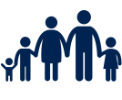Families and children
OECD Family Database
In view of the strong demand for cross-national indicators on the situation of families and children, the OECD Family Database was developed to provide cross-national indicators on family outcomes and family policies across the OECD countries, its enhanced engagement partners and EU member states.
The database brings together information from various national and international databases, both within the OECD (see related OECD databases) and external organisations. The database currently includes 70 indicators under four main dimensions: (i) structure of families, (ii) labour market position of families, (iii) public policies for families and children and (iv) child outcomes.
Each indicator typically presents the data on a particular issue as well as relevant definitions and methodology, comparability and data issues, information on sources and, where relevant, includes the raw data or descriptive information across countries.
1. The structure of families (SF) 
|
2. The labour market position of families (LMF) 
|
|
3. Public policies for families and children (PF)
|
|
(if no weblinks, see the OECD Child Well-Being Data Portal (CWBDP))
|
- OECD Gender data portal: This portal includes selected indicators shedding light on gender inequalities in education, employment, entrepreneurship, health, development, governance, digital and energy, showing how far we are from achieving gender equality and where actions is most needed.
- OECD Benefits and Wages database: This database includes indicators that show how social and fiscal policies affect working and unemployed individuals and their families.
- : This database includes annual data that cover outputs of educational institutions, the policy levers that shape educational outputs, the human and financial resources invested in education, structural characteristics of education systems, and the economic and social outcomes of education.
- OECD Employment database: This database offers a large range up-to-date employment statistics for international comparisons and trends over time.
- OECD Health Statistics: This database provides data on the health status of the population including obesity (overweight, obese), suicide and life expectancy, health care financing, health care resources, social protection, health care utilisation, the pharmaceutical market, long-term care resources and utilisation, non-medical determinants of health, and expenditure on health.
- OECD Income Distribution database: This database provides comparable data on income, income inequality and poverty across OECD countries.
- OECD Social Expenditure database: This database includes reliable and internationally comparable statistics on public and (mandatory and voluntary) private social expenditure at the programme level.
- Family Database in the Asia-Pacific Region: This database, produced and hosted by the OECD KOREA Policy Centre, is based around the OECD Family Database framework and offers a range of data on families, family policies and children for nine Asia-Pacific countries and economies (Australia, China, Hong Kong (China), Japan, Korea, New Zealand, Singapore, Thailand, and Viet Nam).
- OECD Child Well-being Portal: This page provides a platform for conducting policy-oriented research on children, enhancing child well-being and promoting equal opportunities among children.
Contact
For further information or to receive notifications when the database is updated, please contact social.contact@oecd.org.
Follow us on Twitter @OECD_Social
Notes
The structure of the Family database does not include indicators that cover issues related to the position (and care needs) of elderly family members (see pension, health or long-term care webpages).
 This database has been produced with the financial assistance of the European Union. The views expressed herein can in no way be taken to reflect the official opinion of the European Union.
This database has been produced with the financial assistance of the European Union. The views expressed herein can in no way be taken to reflect the official opinion of the European Union.
† The statistical data for Israel are supplied by and under the responsibility of the relevant Israeli authorities. The use of such data by the OECD is without prejudice to the status of the Golan Heights, East Jerusalem and Israeli settlements in the West Bank under the terms of international law.
†† Footnote by Turkey: The information in this document with reference to « Cyprus » relates to the southern part of the Island. There is no single authority representing both Turkish and Greek Cypriot people on the Island. Turkey recognizes the Turkish Republic of Northern Cyprus (TRNC). Until a lasting and equitable solution is found within the context of United Nations, Turkey shall preserve its position concerning the “Cyprus issue”.
†† Footnote by all the European Union Member States of the OECD and the European Union: The Republic of Cyprus is recognized by all members of the United Nations with the exception of Turkey. The information in this document relates to the area under the effective control of the Government of the Republic of Cyprus.
Related Documents

